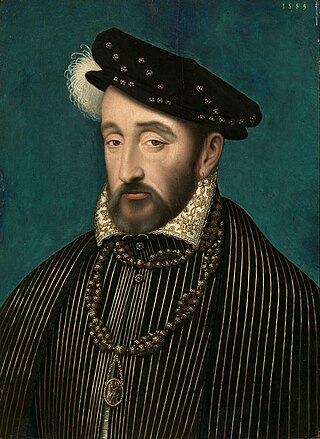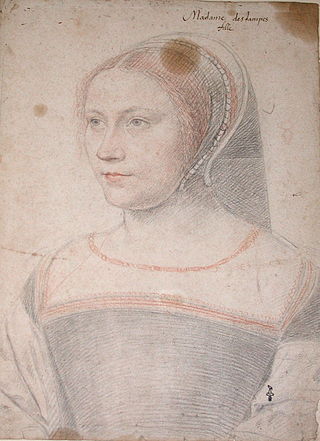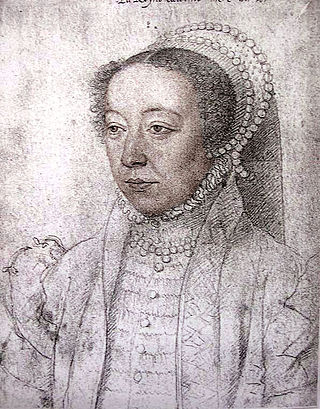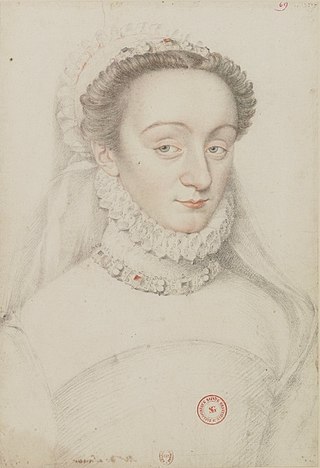
Catherine de' Medici was an Italian (Florentine) noblewoman born into the Medici family. She was Queen of France from 1547 to 1559 by marriage to King Henry II and the mother of French kings Francis II, Charles IX, and Henry III. The years during which her sons reigned have been called "the age of Catherine de' Medici" since she had extensive, if at times varying, influence in the political life of France.

Francis I was King of France from 1515 until his death in 1547. He was the son of Charles, Count of Angoulême, and Louise of Savoy. He succeeded his first cousin once removed and father-in-law Louis XII, who died without a legitimate son.

Charles IX was King of France from 1560 until his death in 1574. He ascended the French throne upon the death of his brother Francis II in 1560, and as such was the penultimate monarch of the House of Valois.

Henry II was King of France from 1547 until his death in 1559. The second son of Francis I and Duchess Claude of Brittany, he became Dauphin of France upon the death of his elder brother Francis in 1536.

Diane de Poitiers was a French noblewoman and prominent courtier. She wielded much power and influence as King Henry II's royal mistress and adviser until his death. Her position increased her wealth and family's status. She was a major patron of French Renaissance architecture.
Duke of Orléans was a French royal title usually granted by the King of France to one of his close relatives, or otherwise inherited through the male line. First created in 1344 by King Philip VI for his younger son Philip, the title was recreated by King Charles VI for his younger brother Louis, who passed the title on to his son and then to his grandson, the latter becoming King Louis XII. The title was created and recreated six times in total, until 1661, when Louis XIV bestowed it upon his younger brother Philippe, who passed it on to his male descendants, who became known as the "Orléans branch" of the Bourbons.

The Treaty of Cambrai is also known as the Paz de las Damas or Paix des Dames. On August 3, 1529, this agreement ended the French involvement in the War of the League of Cognac between the French king Francis I and the Spanish Habsburg emperor Charles V. The treaty temporarily confirmed Spanish (Habsburg) hegemony in the Duchy of Milan and in Southern Italy.

The Italian War of 1521–1526, sometimes known as the Four Years' War, was a part of the Italian Wars. The war pitted Francis I of France and the Republic of Venice against the Holy Roman Emperor Charles V, Henry VIII of England, and the Papal States. It arose from animosity over the election of Charles as Emperor in 1519–1520 and from Pope Leo X's need to ally with Charles against Martin Luther.

Charles II of Orléans was the third son of Francis I and Claude of France.

Francis III was Dauphin of France and, after 1524, Duke of Brittany. Francis and his brother, Henry, were exchanged as hostages for their father, Francis I, who had been captured at the Battle of Pavia. They would be hostages for three years. Made duke of Brittany in 1532, this precipitated Brittany's integration with the Kingdom of France. Francis died 10 August 1536, possibly from tuberculosis.

Nicolas IV de Neufville, seigneur de Villeroy was a secretary of state under four kings of France: Charles IX, Henry III, Henry IV, and Louis XIII. The most distinguished of all sixteenth-century French secretaries, Villeroy rose to prominence during the French Wars of Religion, a period of almost insoluble difficulties for the French monarchy and government. Despite faithfully serving Henry III, Villeroy found himself sacked by him without explanation in 1588, along with all the king's ministers. He was reinstated by Henry IV in 1594 and became more important than ever before. He remained in office until his death in 1617 during the reign of Louis XIII.

The Valois Tapestries are a series of eight large tapestries depicting festivities or "magnificences" held by Catherine de' Medici's Royal Courts in the second half of the 16th century. The tapestries were primarily modeled on drawings by Antoine Caron, but to Caron's distant views of large panoramas crowded with figures much larger portraits of leading persons at the French court have been added in the foreground, usually to the side, as well as elaborate borders.

Catherine de' Medici was also patron for building projects including the Valois chapel at Saint-Denis, the Tuileries Palace, and the Hôtel de la Reine in Paris, and extensions to the château of Chenonceau, near Blois. Born in 1519 in Florence to an Italian father and a French mother, Catherine de' Medici was a daughter of both the Italian and the French Renaissance. She grew up in Florence and Rome under the wing of the Medici popes, Leo X and Clement VII. In 1533, at the age of fourteen, she left Italy and married Henry, the second son of Francis I and Queen Claude of France. On doing so, she entered the greatest Renaissance court in northern Europe.

Catherine de' Medici's court festivals were a series of lavish and spectacular entertainments, sometimes called magnificences, laid on by Catherine de' Medici, the queen consort of France from 1547 to 1559 and queen mother from 1559 until her death in 1589. As queen consort of Henry II of France, Catherine showed interest in the arts and theatre, but it was not until she attained real political and financial power as queen mother that she began the series of tournaments and entertainments that dazzled her contemporaries and continue to fascinate scholars. Biographer Leonie Frieda suggests that "Catherine, more than anyone, inaugurated the fantastic entertainments for which later French monarchs also became renowned".

Catherine de' Medici was a patron of the arts made a significant contribution to the French Renaissance. Catherine was inspired by the example of her father-in-law, King Francis I of France, who had hosted the leading artists of Europe at his court. As a young woman, she witnessed at first hand the artistic flowering stimulated by his patronage. As governor and regent of France, Catherine set out to imitate Francis's politics of magnificence. In an age of civil war and declining respect for the monarchy, she sought to bolster royal prestige through lavish cultural display.

Henry IV of France's wives and mistresses played a significant role in the politics of his reign. Both Henry (1553–1610) and his first wife Margaret of Valois, whom he married in 1572, were repeatedly unfaithful to each other, and the collapse of their marriage led to their estrangement and living apart. Although Henry fathered children with a series of mistresses, his lack of a legitimate heir became a cause of concern, and his marriage was not annulled until 1599. In 1600, at the age of forty-six, he married his second wife, Marie de' Medici. They had six children, including the future Louis XIII. Henry was unfaithful to his second wife as well and insisted that she raise his illegitimate children along with her own.

Charlotte de Beaune Semblançay, Viscountess of Tours, Baroness de Sauve, Marquise de Noirmoutier was a French noblewoman and a mistress of King Henry of Navarre, who later ruled as King Henry IV of France. She was a member of queen mother Catherine de' Medici's notorious "Flying Squadron", a group of beautiful female spies and informants recruited to seduce important men at Court, and thereby extract information to pass on to the Queen Mother.
Filippa Duci or Filippa Ducci, dame de Couy, was a French courtesan. She was the mother of Diane de France.

The Hôtel de Soissons was a hôtel particulier built in Paris, France, between 1574 and 1584 for Catherine de' Medici (1519–89) by the architect Jean Bullant (1515–78). It replaced a series of earlier buildings on the same site. After Catherine's death the hotel was enlarged and embellished. The last owner, Victor Amadeus I, Prince of Carignano, installed the Paris Bourse in the gardens, He was forced to sell it in 1740 to pay his debts. It was demolished in 1748 and the materials sold. A corn exchange was built on the site, later replaced by the present Bourse de commerce. A column, thought to have been used for astrological observations, is all that remains.

Claude d'Urfé was a French royal official of the 16th century. He acted as governor and bailiff of Forez after that county became a royal domain. He was a friend and confidant of Francis I and fought alongside him in the Wars of Italy as well as under his son Henry II. He was also governor of the dauphin and the king's other children. He was also a major patron for building works in the Italian Renaissance style in Forez, such as his Italian-style extension to his château of Bastie d'Urfé. His grandson was the author Honoré d'Urfé.


















